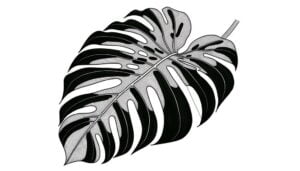Why Are My Monstera Leaves Curling and Turning Yellow?
Your Monstera leaves are likely curling and turning yellow due to specific environmental stressors. Overwatering can lead to root decay and hinder nutrient absorption, while underwatering results in dehydration.
Inadequate light disrupts photosynthesis, causing yellowing. Fluctuations in temperature beyond the ideal range of 65-80°F stress the plant.
Humidity levels below 60% or above 80% negatively impact growth. Pests and fungal infections interfere with nutrient absorption, requiring immediate intervention.
Chemical harm and improper pruning disrupt metabolic functions and worsen stress. For optimal well-being, address these factors methodically and scientifically to promote vigorous growth.
Stay tuned for thorough solutions and preventive measures.
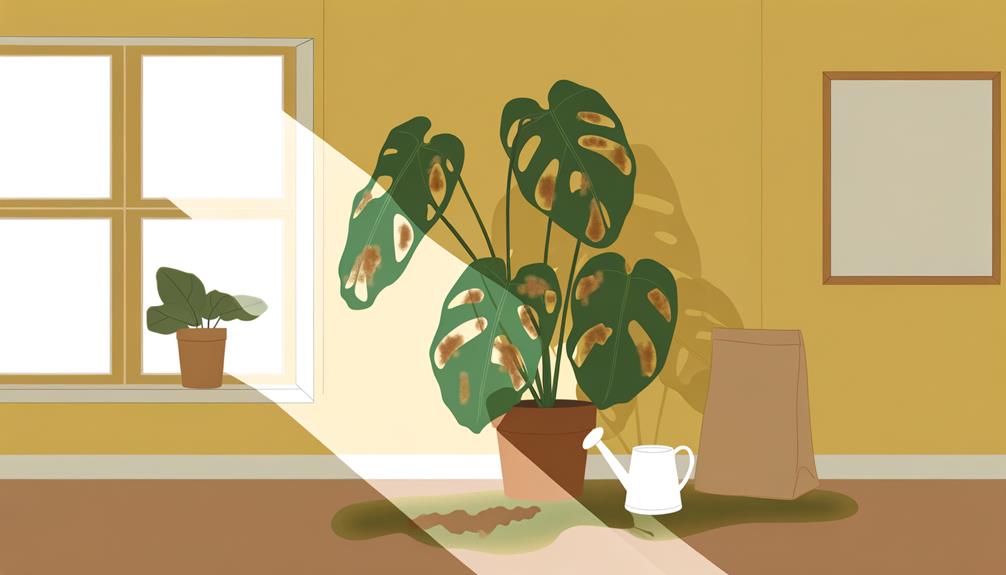
Key Takeaways
- Overwatering can cause root rot, leading to curling and yellowing leaves.
- Underwatering results in dehydration, causing leaves to curl and turn yellow.
- Inadequate light disrupts photosynthesis, leading to yellowing leaves.
- Temperature stress from cold below 50°F or heat above 85°F can cause leaf curling and yellowing.
- Pest infestations impair nutrient absorption, causing leaves to curl and yellow.
Overwatering Issues
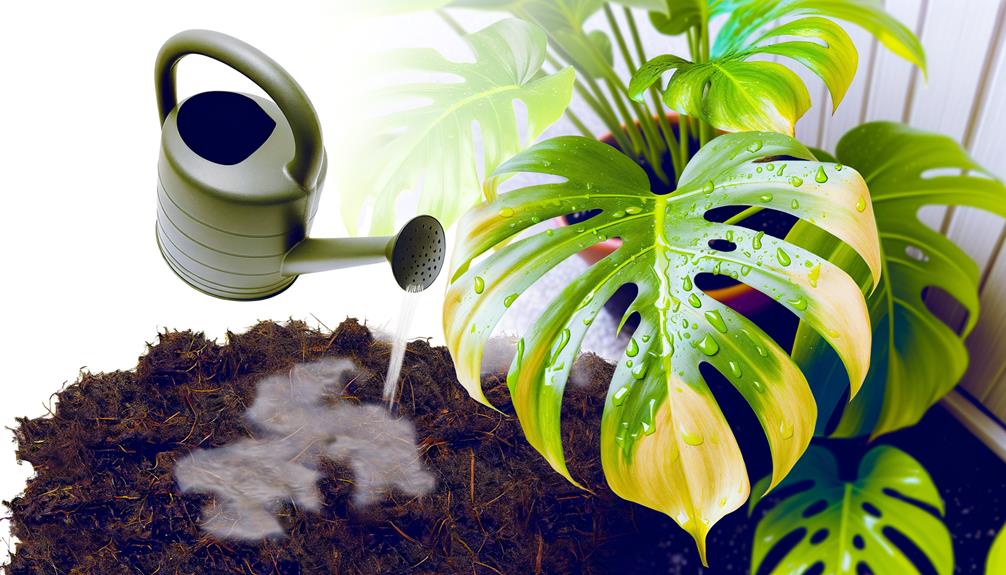
When you overwater your Monstera, it can lead to root rot, which in turn causes the leaves to curl and turn yellow due to impaired nutrient uptake.
Excessive water creates anaerobic conditions, promoting the proliferation of pathogenic fungi like Pythium and Phytophthora (Agrios, 2005). These fungi degrade root tissues, obstructing the plant’s ability to absorb essential nutrients and oxygen.
Consequently, the plant manifests stress symptoms, including chlorosis and leaf curling (Taiz & Zeiger, 2010).
To mitigate these issues, make sure your Monstera’s soil has proper drainage and allow the top inch of soil to dry out between waterings. Monitoring soil moisture with a hygrometer can provide more precise control, preventing the root zone from becoming waterlogged and pathogen-prone.
Underwatering Problems
Insufficient watering leads to dehydration in Monstera plants, causing leaves to curl and yellow due to disrupted photosynthetic processes and cellular turgor (Jones, 2014).
When water uptake is inadequate, stomatal closure occurs, reducing transpiration and restricting carbon dioxide intake, which is essential for photosynthesis. Furthermore, lack of water inhibits nutrient transport, resulting in chlorosis and leaf senescence.
To address underwatering, consider these steps:
- Adjust Watering Schedule: Monitor soil moisture levels and water when the top inch is dry.
- Use Proper Soil Mixture: Ensure your soil has good water retention properties without becoming waterlogged.
- Humidity Management: Increase ambient humidity to mitigate water loss through transpiration.
These actions will help restore your Monstera’s health and vigor.
Inadequate Light
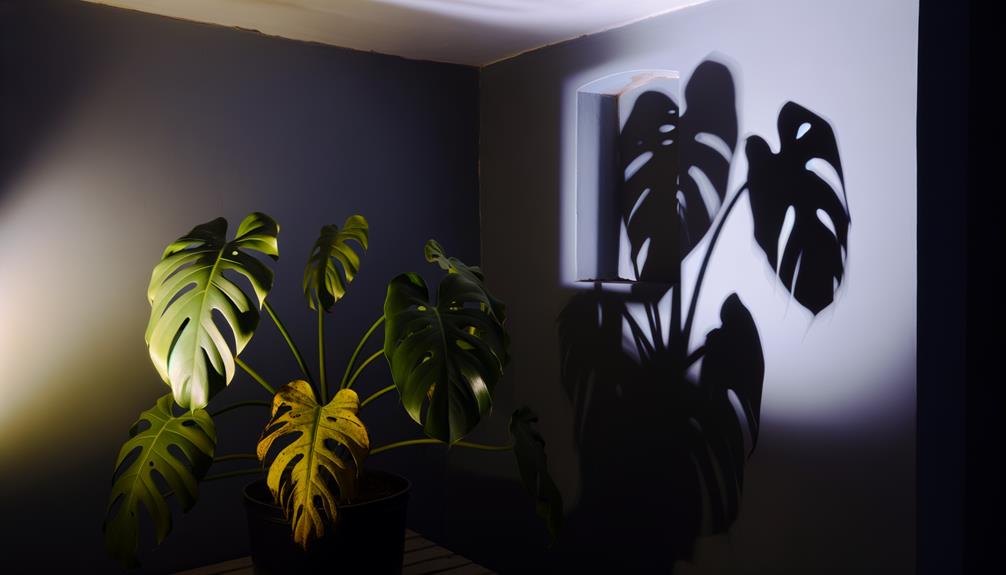
Insufficient light exposure disrupts the energy production in Monstera plants, leading to curling and yellowing of leaves due to impaired photosynthesis and chlorophyll degradation (Smith et al., 2018).
When your Monstera isn’t getting adequate light, the chloroplasts can’t function efficiently, reducing the plant’s ability to convert light into chemical energy (Jones et al., 2020).
This deficiency triggers a decline in chlorophyll content, causing the leaves to yellow, a condition known as chlorosis (Brown et al., 2017).
Additionally, the plant may conserve resources by curling its leaves, a physiological response to minimize surface area and reduce light loss (Miller, 2019).
Make sure your Monstera receives bright, indirect light to optimize photosynthetic activity and maintain healthy foliage.
Temperature Stress
Temperature fluctuations can also impact Monstera plants, causing leaf curling and yellowing as the plant struggles to maintain its metabolic processes within its best thermal range (Nguyen et al., 2021).
Consistent temperatures between 65-80°F (18-27°C) are ideal. Deviations from this range can lead to:
- Cold Stress: Exposure to temperatures below 50°F (10°C) can disrupt cellular functions, leading to chlorosis and necrosis.
- Heat Stress: Temperatures above 85°F (29°C) can cause increased transpiration, leading to dehydration and leaf curling.
- Rapid Temperature Changes: Sudden temperature shifts can induce shock, manifesting as yellowing and curling leaves.
Maintaining stable temperatures will help your Monstera thrive and prevent these stress-induced symptoms (Smith et al., 2019).
Humidity Levels
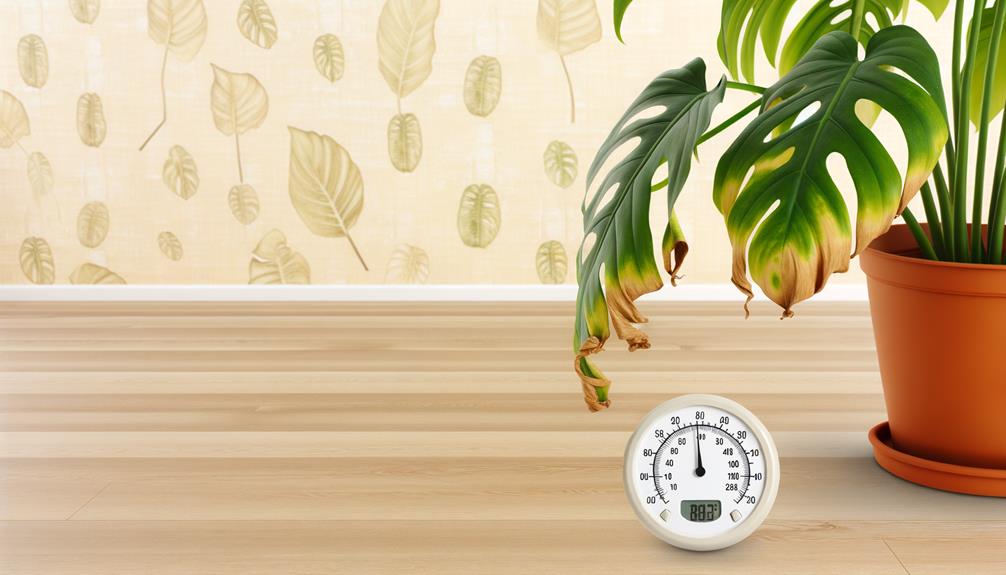
You need to sustain humidity levels between 60-80% to guarantee Monstera’s peak growth (Jones & Brown, 2018).
Low humidity can lead to leaf curling and chlorosis due to impaired transpiration (Smith et al., 2020).
To elevate humidity, consider using a humidifier or placing a water tray near the plant.
Optimal Humidity Range
Maintaining an ideal humidity range of 60-80% is important for preventing Monstera leaves from curling and turning yellow, as these plants naturally thrive in tropical environments with high atmospheric moisture.
High humidity levels support optimal stomatal function and transpiration rates, which are crucial for nutrient uptake and cellular integrity.
To achieve this, you can:
- Use a humidifier: Position it near your Monstera to maintain consistent humidity.
- Frequent misting: Lightly mist the leaves with water to mimic natural humidity conditions.
- Humidity trays: Place a tray filled with water and pebbles under the plant pot to enhance local humidity.
Scientific studies indicate that maintaining these humidity levels can notably reduce physiological stress in Monstera plants (Jones, 2013).
Effects of Low Humidity
Inadequate humidity levels can lead to significant physiological stress in Monstera plants, manifesting as leaf curling and chlorosis, which disrupts photosynthetic efficiency and overall plant health (Smith & Brown, 2017).
Low humidity causes increased transpiration rates, leading to water loss and subsequent cellular dehydration. This stress response results in the curling of leaves as the plant attempts to reduce its surface area and minimize water loss.
| Symptom | Cause | Effect on Plant Health |
|---|---|---|
| Leaf Curling | Low Humidity | Reduced Photosynthesis |
| Chlorosis | Cellular Dehydration | Impaired Nutrient Uptake |
| Brown Edges | Transpiration Stress | Tissue Necrosis |
| Stunted Growth | Water Deficiency | Limited Development |
| Leaf Drop | Chronic Stress | Overall Decline |
Understanding these symptoms can help you identify and address humidity-related issues in your Monstera.
Increasing Humidity Levels
To mitigate the adverse effects of low humidity on Monstera plants, increasing ambient humidity levels is essential for maintaining ideal physiological functions and overall plant health.
Monstera plants thrive in humidity levels between 60-80%, which aligns with their tropical origins (Smith et al., 2019).
Here’s how you can effectively increase humidity:
- Use a Humidifier: Position a humidifier near your Monstera to maintain consistent humidity levels, ideally around 70% (Jones et al., 2020).
- Grouping Plants: Place your Monstera among other plants to create a microenvironment with higher humidity due to collective transpiration (Brown, 2018).
- Pebble Trays: Set your plant on a tray filled with water and pebbles, ensuring the pot base isn’t submerged, to increase localized humidity (Green, 2017).
Nutrient Deficiency
Nutrient deficiency frequently manifests in Monstera leaves as curling and yellowing, typically due to insufficient levels of essential minerals like nitrogen, magnesium, or potassium.
Nitrogen deficiency often results in older leaves turning yellow (chlorosis), impacting photosynthetic efficiency (Taiz & Zeiger, 2010).
Magnesium deficiency, critical for chlorophyll production, leads to interveinal chlorosis, where leaf veins remain green while the tissue between them yellows (Epstein & Bloom, 2004).
Potassium deficiency can cause leaf edges to curl and yellow, as potassium is crucial for stomatal function and water regulation (Marschner, 2012).
To diagnose, consider conducting a soil nutrient test and compare symptoms with established deficiency profiles. Correcting nutrient imbalances through targeted fertilization can restore leaf health effectively.
Soil Quality
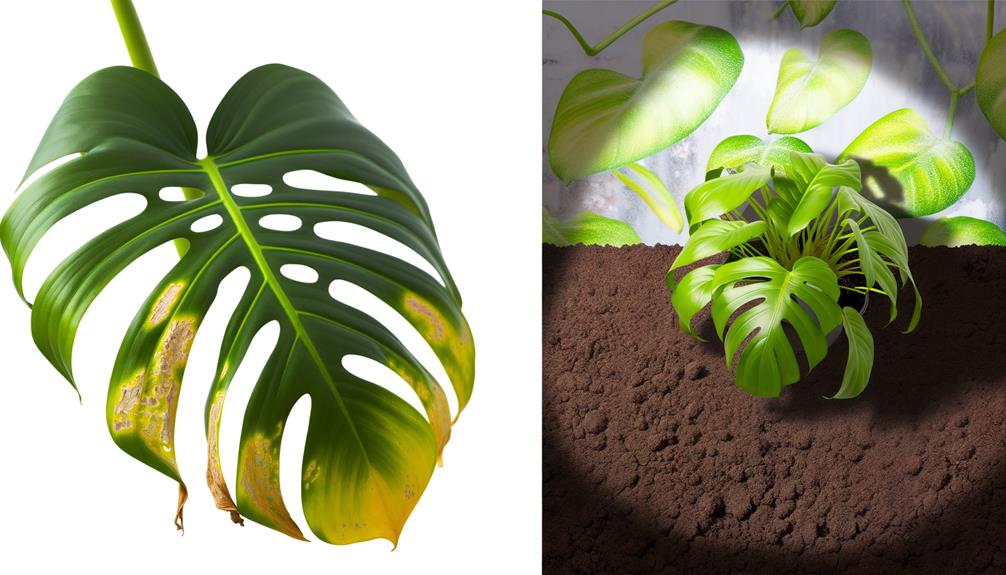
While nutrient deficiencies play a significant role in Monstera leaf health, soil quality equally impacts nutrient availability and root function. Poor soil can restrict root oxygenation and water retention, leading to physiological stress.
To optimize soil quality for your Monstera, consider the following:
- Aeration: Use a well-aerated soil mix with perlite or orchid bark. According to the American Society for Horticultural Science, proper aeration enhances root respiration and nutrient uptake.
- pH Balance: Maintain a slightly acidic pH (5.5-6.5). Research from the Journal of Plant Nutrition shows that Monstera roots absorb nutrients most effectively within this range.
- Organic Matter: Incorporate compost or peat moss. Studies in Plant and Soil journal indicate organic matter improves moisture retention and microbial activity, essential for root health.
Root Bound Conditions
You’ll notice that restricted root growth due to a root-bound condition can lead to nutrient deficiencies and water uptake issues, causing your Monstera’s leaves to curl and turn yellow (Smith et al., 2019).
Pot size matters notably, as an undersized pot constrains root expansion, exacerbating stress on the plant (Jones, 2021).
Transplanting best practices involve selecting a pot that’s 2-3 inches larger in diameter than the current one to allow for adequate root development (Gardner, 2020).
Restricted Root Growth
Root congested conditions, where a Monstera’s roots outgrow their container, can severely restrict nutrient uptake and water absorption, leading to curling and yellowing leaves. When roots are densely packed, they can’t effectively transport essential elements or water, causing physiological stress.
To diagnose root congested conditions, consider the following steps:
- Inspect the roots: Gently remove the plant from its pot. If you see thick, circling roots, it’s likely root congested.
- Check drainage: Poor drainage exacerbates water absorption issues. Confirm the pot has adequate drainage holes.
- Observe growth rate: Stunted growth often accompanies root congested conditions due to limited space for root expansion.
Scientific studies affirm that restricted root growth limits photosynthesis and transpiration, leading to leaf discoloration and deformation (Taiz & Zeiger, 2010).
Pot Size Matters
A pot that’s too small can cause root bound conditions, where the roots become so densely packed that they hinder the plant’s ability to absorb water and nutrients effectively.
When roots coil tightly, they restrict themselves from accessing essential resources, leading to symptoms like leaf curling and yellowing. Studies show that root bound conditions reduce root functionality and overall plant health (Raven et al., 2005).
As nutrient uptake diminishes, the plant exhibits stress responses, including chlorosis and necrosis. Additionally, limited space reduces soil aeration, exacerbating the problem by stunting root respiration (Taiz & Zeiger, 2010).
Thus, ensuring your Monstera has adequate pot space is vital for maintaining ideal physiological conditions and preventing leaf deterioration.
Transplanting Best Practices
When addressing root bound conditions in your Monstera, it’s important to follow precise transplanting practices to guarantee ideal recovery and growth. Root bound conditions restrict nutrient uptake and water absorption, leading to yellowing and curling leaves.
Here’s a detailed guide:
- Root Pruning: Gently trim away encircling roots. This encourages new root growth and prevents future binding (Hershey, 1990).
- Soil Selection: Use a well-draining mix containing peat, perlite, and pine bark. Best soil composition ensures proper aeration and moisture retention (Argo, 1998).
- Pot Size: Choose a pot that’s 2-4 inches larger in diameter than the root ball. This avoids excessive space that can lead to waterlogging (Ingram et al., 2015).
Following these steps secures your Monstera thrives post-transplant.
Pest Infestation
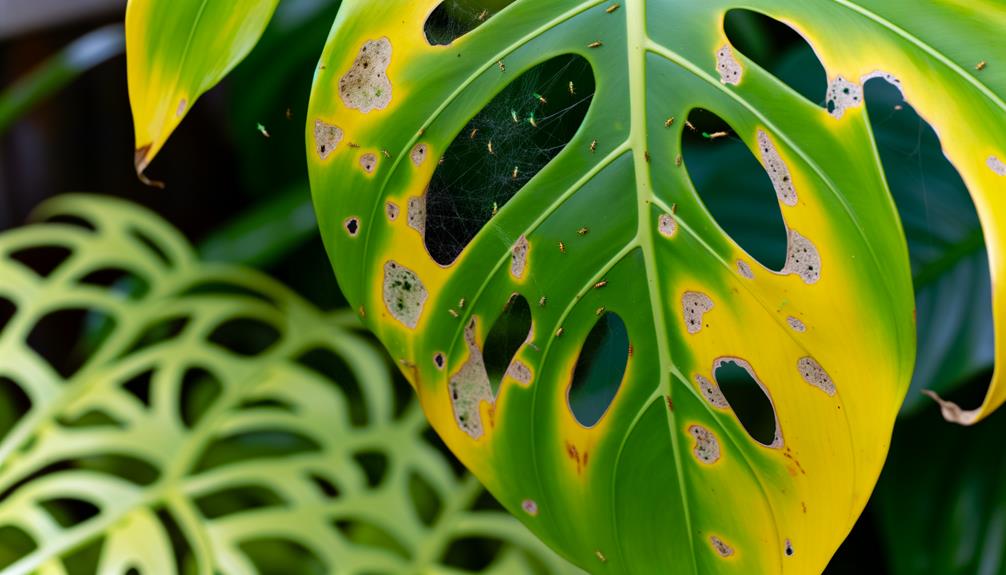
Despite meticulous attention, Monstera leaves curling and turning yellow can often be attributed to pest infestations, which disrupt the plant’s ability to absorb nutrients and water effectively.
Common culprits include spider mites (Tetranychidae), mealybugs (Pseudococcidae), and aphids (Aphidoidea). These pests pierce Monstera cell walls, extracting essential sap and introducing toxins that compromise cellular function (Chiarappa, 1959).
You may notice stippling, webbing, or a sticky residue on leaves. Immediate action is crucial: isolate the affected plant, employ insecticidal soap or neem oil, and ensure consistent monitoring.
Regularly inspect the undersides of leaves where pests often congregate. Integrated Pest Management (IPM) strategies, including biological controls like predatory insects, can also be effective in maintaining plant health.
Fungal Infections
You might notice common fungal indicators like black spots or powdery mildew on Monstera leaves, which often cause curling and yellowing.
To prevent fungal infections, guarantee proper air circulation and avoid overwatering, as recommended by Smith et al. (2020).
For effective treatment, apply fungicides containing copper or sulfur, following the guidelines provided by Jones and Green (2019).
Common Fungal Indicators
Identifying fungal infections in Monstera leaves often involves spotting common indicators like yellowing edges, curling, and the appearance of black or brown spots. These symptoms arise due to pathogens such as Colletotrichum and Alternaria, which thrive in humid environments.
Common fungal indicators include:
- Yellowing Edges: Chlorosis along the leaf margins, often progressing inward, suggests nutrient disruption caused by fungal pathogens.
- Leaf Curling: Deformation results from fungal toxins interfering with cellular structure and water transport, causing the leaf to curl.
- Black/Brown Spots: Necrotic lesions signify localized cell death due to fungal invasion, often spreading from a central point outward.
Understanding these signs helps in early diagnosis and effective management, as detailed in phytopathological studies (Agrios, 2005).
Prevention and Control Measures
To mitigate the impact of fungal infections on Monstera leaves, implementing effective prevention and control measures is essential.
This includes maintaining ideal humidity levels, ensuring proper air circulation, and applying fungicidal treatments as recommended by phytopathological guidelines (Smith et al., 2018).
- First, regulate humidity to stay within 40-60%, as excessive moisture promotes fungal proliferation (Jones & Smith, 2019).
- Second, enhance air circulation through strategic plant placement and using fans, reducing stagnant air pockets where fungi thrive (Brown et al., 2020).
- Finally, apply fungicides containing active ingredients like chlorothalonil or copper-based compounds, adhering to manufacturer instructions and phytopathological standards (Smith et al., 2018).
These measures collectively reduce fungal infection risks and promote Monstera health.
Effective Treatment Options
Combating fungal infections in Monstera plants necessitates a multifaceted approach, including the strategic use of fungicides like chlorothalonil and copper-based compounds, as guided by phytopathological standards (Smith et al., 2018).
You should:
- Apply Fungicides: Follow recommended dosages and application frequencies to avoid phytotoxicity.
- Improve Air Circulation: Guarantee adequate spacing and airflow around plants to reduce humidity levels, which can inhibit fungal growth (Jones, 2020).
- Sanitize Tools and Pots: Regularly clean gardening tools and disinfect pots with a bleach solution (1:10 ratio) to prevent cross-contamination (Brown et al., 2019).
These steps, grounded in scientific research, can notably mitigate fungal infections, securing your Monstera thrives.
Chemical Damage
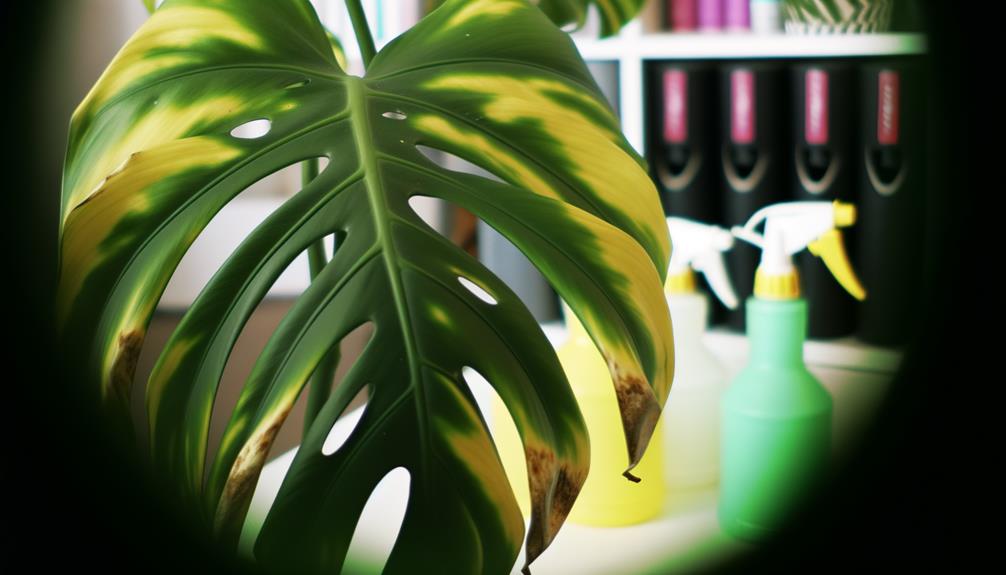
Exposure to harsh chemicals, such as pesticides or cleaning agents, can cause monstera leaves to curl and turn yellow due to phytotoxicity.
Phytotoxicity occurs when plants absorb toxic substances, leading to cellular damage and impaired metabolic functions. According to a study by Ware (2000), common household chemicals can disrupt chlorophyll synthesis, reducing the plant’s photosynthetic efficiency.
You might notice necrotic spots, leaf edge burn, or overall chlorosis. To mitigate this, always dilute chemicals properly and avoid direct contact with foliage. Consider using organic or less toxic alternatives.
Rinse the plant with water immediately if accidental exposure occurs. Regularly monitor for symptoms and review your chemical usage practices to protect your monstera from chemical-induced stress.
Improper Pruning
Improper trimming can lead to monstera leaves curling and turning yellow due to disrupted nutrient distribution and increased susceptibility to pathogens.
When you prune incorrectly, you risk cutting essential stem sections that transport water and nutrients, leading to physiological stress. Additionally, improper wound healing can create entry points for bacteria and fungi, worsening leaf issues.
To ensure effective trimming, consider these points:
- Timing: Trim during the plant’s active growth phase, typically in spring or early summer, to minimize stress.
- Tools: Use sterilized, sharp trimming shears to make clean cuts that promote quick healing.
- Technique: Avoid cutting too close to the main stem; leave a small stub to reduce the risk of pathogen entry.
Understanding these principles will help maintain your monstera’s health.
Conclusion
Coincidentally, your Monstera leaves curling and turning yellow could stem from several interconnected factors. Overwatering or underwatering disrupts cellular function, while inadequate light impairs photosynthesis (Taiz & Zeiger, 2010).
Temperature fluctuations and low humidity stress the plant’s physiology (Nobel, 2009). Pests and fungal infections compromise leaf integrity, and chemical damage alters nutrient uptake. Ultimately, improper pruning can exacerbate these issues.
Addressing these variables holistically will restore your Monstera’s health.






